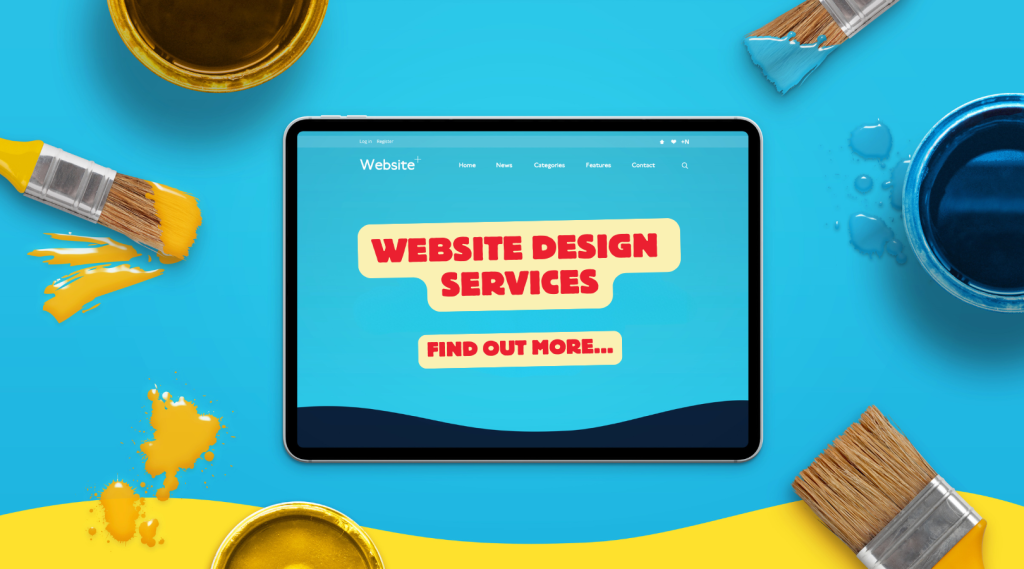- 1. User-Centric Design: Putting Visitors First
- 2. Simplicity is Key: Less is More
- 3. Visual Hierarchy: Guide the User’s Eye
- 4. Mobile Responsiveness: Design for All Devices
- 5. Fast Loading Times: Speed Matters
- 6. Clear Navigation: Keep It Simple and Intuitive
- 7. Consistent Branding: Build Trust and Recognition
- 8. Content is King: Quality Over Quantity
- 9. Calls to Action: Motivate Your Users
- 10. Trustworthiness: Build Credibility with Your Audience
- 11. Regular Updates: Keep Your Website Fresh
- 12. Feedback and Testing: Continuous Improvement
- 13. Social Proof: Influence Through Validation
- 14. Effective Use of Imagery: Visual Appeal with Purpose
- 15. Interactive Elements: Engage and Delight Users
- The Path to a Stunning Website: Effective Website Design Principles
In the digital age, your website is often the first impression potential customers have of your brand. It’s your digital storefront, and just like a physical store, the design can either attract customers or send them running to your competitors. Effective website design is not just about looking pretty; it’s about creating an experience that is intuitive, engaging, and aligns with your business goals.
Whether you’re a seasoned web designer or a business owner looking to revamp your online presence, understanding Effective Website Design Principles is crucial. These principles can make the difference between a visitor who becomes a loyal customer and one who clicks away in frustration.

1. User-Centric Design: Putting Visitors First
The most important principle of effective website design is to focus on the user. A user-centric design ensures that every element on your site is created with your audience’s needs in mind. This involves understanding your target audience, including their preferences, behavior, and challenges.
Effective Website Design Principles
How to Apply User-Centric Design:
- Persona Creation: Develop detailed personas of your ideal users. What are their goals? What problems are they looking to solve?
- User Journey Mapping: Visualize the steps a visitor takes from arriving on your site to completing their objective. Ensure the journey is smooth and intuitive.
- Accessibility: Ensure your site is accessible to everyone, including those with disabilities. Use tools like alt text for images and ensure your site is navigable via keyboard for those who can’t use a mouse.
2. Simplicity is Key: Less is More
One of the most common mistakes in web design is overcrowding a page with too much information. Simplicity doesn’t mean your website should be plain or boring, but rather that every element should serve a clear purpose. A cluttered design can overwhelm users and make navigation difficult.
Strategies for Simplifying Your Design:
- Focus on Core Elements: Identify the key components that should be on each page and eliminate anything unnecessary.
- Whitespace: Use whitespace strategically to give elements room to breathe. This can enhance the clarity of your design and make the content more digestible.
- Consistent Design Language: Stick to a consistent color scheme, typography, and style throughout your site. This helps create a unified and professional look.
3. Visual Hierarchy: Guide the User’s Eye
Visual hierarchy refers to the arrangement or presentation of elements in a way that implies importance. It’s about guiding your users’ eyes to the most critical areas of your site first, such as calls to action (CTAs) or important information.
Creating Effective Visual Hierarchy:
- Size and Scale: Larger elements naturally draw more attention. Use size to highlight the most important parts of your site, like headlines or CTAs.
- Color and Contrast: Use contrasting colors to make key elements stand out. A brightly colored CTA button on a neutral background, for example, will attract more clicks.
- Positioning: Place essential elements where the eye is likely to fall first, such as the top-left corner or the center of the screen.
4. Mobile Responsiveness: Design for All Devices
With mobile devices accounting for a significant portion of web traffic, ensuring your site is mobile-friendly is no longer optional—it’s essential. A responsive design automatically adjusts to different screen sizes, providing an optimal user experience across devices.
Tips for Mobile Responsiveness:
- Flexible Grids: Use flexible grid layouts that adjust based on the screen size.
- Scalable Images: Ensure that images scale appropriately on different devices without losing quality.
- Touch-Friendly Elements: Buttons and links should be easy to tap on a small screen. Avoid placing links too close together to prevent accidental clicks.
5. Fast Loading Times: Speed Matters
In today’s fast-paced world, users expect websites to load in the blink of an eye. Slow loading times can frustrate users and lead to higher bounce rates. In fact, studies show that if a website takes longer than three seconds to load, most users will abandon it.
Ways to Improve Load Times:
- Optimize Images: Compress images without sacrificing quality to reduce their load time.
- Minimize Code: Streamline your website’s code by removing unnecessary characters, spaces, and lines.
- Leverage Browser Caching: Enable browser caching so that returning visitors don’t have to reload your entire site every time they visit.
6. Clear Navigation: Keep It Simple and Intuitive
Effective navigation is critical for a positive user experience. If visitors can’t find what they’re looking for quickly, they’ll likely leave your site. Clear, intuitive navigation helps users explore your site easily, increasing the chances of them finding the information they need.
Effective Website Design Principles Effective Website Design Principles Effective Website Design Principles
Best Practices for Navigation:
- Logical Structure: Organize your navigation menu in a way that makes sense to users. Group related pages together and use clear, descriptive labels.
- Breadcrumbs: Use breadcrumb trails to help users understand their location within your site and navigate back to previous pages easily.
- Search Functionality: Include a search bar to allow users to quickly find specific content on your site.
7. Consistent Branding: Build Trust and Recognition
Your website is an extension of your brand, so it’s important that your branding is consistent across all pages. Consistent branding helps build trust with your audience and makes your site more recognizable.
How to Ensure Consistent Branding:
Effective Website Design Principles Effective Website Design Principles Effective Website Design Principles
- Logo Placement: Place your logo in a prominent position, such as the top-left corner of your website, and link it to your homepage.
- Color Scheme: Stick to a color palette that aligns with your brand identity. Use these colors consistently throughout your site.
- Typography: Choose fonts that reflect your brand’s personality and use them consistently for headings, body text, and CTAs.
8. Content is King: Quality Over Quantity
Even the most beautifully designed website will fall flat if the content doesn’t resonate with your audience. High-quality content that is relevant, informative, and engaging is essential for effective website design.
Creating Quality Content:
- Know Your Audience: Write content that speaks directly to your target audience. Address their pain points, answer their questions, and provide value.
- SEO Optimization: Optimize your content for search engines by using relevant keywords naturally throughout your text. This will help improve your website’s visibility in search engine results.
- Multimedia Elements: Incorporate images, videos, infographics, and other multimedia elements to make your content more engaging and easier to digest.
Effective Website Design Principles Effective Website Design Principles Effective Website Design Principles
9. Calls to Action: Motivate Your Users
A call to action (CTA) is a prompt that encourages users to take a specific action, such as signing up for a newsletter, downloading a resource, or making a purchase. Effective CTAs are crucial for converting visitors into leads or customers.
Designing Effective CTAs:
- Clear and Concise: Make sure your CTA is straightforward and tells users exactly what you want them to do (e.g., “Sign Up Now,” “Download the Guide”).
- Visibility: Place CTAs in prominent locations where they’re easy to see, such as at the top of a page, within content, or as a pop-up.
- Compelling Copy: Use action-oriented language that motivates users to take the desired action. Highlight the benefits they’ll receive by clicking the CTA.
Effective Website Design Principles Effective Website Design Principles Effective Website Design Principles
Effective Website Design Principles Effective Website Design Principles Effective Website Design Principles
10. Trustworthiness: Build Credibility with Your Audience
Trust is a critical component of any successful website. Users are more likely to engage with a site they find credible. Trustworthiness can be conveyed through various design elements and content strategies.
Building Trustworthiness:
Effective Website Design Principles Effective Website Design Principles Effective Website Design Principles
- Security Features: Display security badges and SSL certificates, especially on pages where users are required to enter personal information.
- Testimonials and Reviews: Showcase customer testimonials, reviews, and case studies to provide social proof of your product or service’s quality.
- Transparent Information: Clearly present your contact information, privacy policy, and terms of service. This transparency reassures users that your business is legitimate and trustworthy.
11. Regular Updates: Keep Your Website Fresh
A stale website can give the impression that your business is outdated. Regularly updating your content and design ensures that your website remains relevant and engaging for users.
Strategies for Regular Updates:
- Content Calendar: Create a content calendar to plan and schedule regular updates, such as blog posts, news articles, and product announcements.
- Design Tweaks: Periodically review your design and make small adjustments to keep your site looking fresh. This could include updating images, changing color schemes, or experimenting with new layouts.
- Performance Audits: Conduct regular audits to assess your website’s performance. Check for broken links, outdated content, and areas where you can improve usability.
Effective Website Design Principles Effective Website Design Principles Effective Website Design Principles
12. Feedback and Testing: Continuous Improvement
Effective website design is an ongoing process. Gathering feedback and testing different elements of your site can help you identify areas for improvement and enhance the user experience.
Implementing Feedback and Testing:
- User Testing: Conduct user testing sessions where real people navigate your site while you observe. This can reveal pain points and areas of confusion that you might not have noticed.
- A/B Testing: Experiment with different versions of your web pages to see which design elements perform best. For example, test different CTA placements or color schemes to see which version yields higher conversions.
- Analytics: Use tools like Google Analytics to track user behavior on your site. Analyzing data such as bounce rates, time on page, and conversion rates can provide valuable insights into how users are interacting with your site.
Effective Website Design Principles Effective Website Design Principles Effective Website Design Principles
13. Social Proof: Influence Through Validation
Humans are social creatures who often look to others when making decisions. Incorporating social proof into your website design can influence user behavior and boost conversions.
Incorporating Social Proof:
- Customer Reviews: Display customer reviews prominently on product pages to build trust and encourage purchases.
- User-Generated Content: Feature photos, videos, or testimonials from real customers who have used your products or services.
- Social Media Integration: Showcase your social media presence by including feeds or follower counts on your website. This demonstrates that others engage with and trust your brand.
14. Effective Use of Imagery: Visual Appeal with Purpose
Images can be powerful tools in web design when used correctly. However, they need to be relevant and high quality to enhance the user experience.
Maximizing the Impact of Imagery:
- High-Resolution Images: Use high-resolution images that look professional and clear. Blurry or pixelated images can make your site appear unprofessional.
- Relevance: Ensure that your images are directly related to the content they accompany. Irrelevant images can confuse users and dilute your message.
- Alt Text: Include descriptive alt text for all images to improve accessibility and help with SEO.
15. Interactive Elements: Engage and Delight Users
Interactive elements can make your website more engaging and provide a memorable experience for users. However, they should enhance the user experience, not distract from it.
Implementing Interactive Elements:
- Animations: Use subtle animations to draw attention to key areas of your site, like hovering effects on buttons or transitions between pages.
- Forms and Surveys: Incorporate interactive forms or surveys to collect user feedback or information. Make these elements easy to use and visually appealing.
- Chatbots: Add a chatbot to provide instant assistance to visitors. This can improve customer service and increase user satisfaction.
The Path to a Stunning Website: Effective Website Design Principles
Effective website design is both an art and a science. It requires a deep understanding of your users, careful planning, and a commitment to continuous improvement. By focusing on user-centric design, simplicity, mobile responsiveness, and the other principles outlined above, you can create a website that not only looks great but also drives results.
Remember, your website is a reflection of your brand. Investing in a well-designed site is an investment in your business’s future success. So, embrace these principles, get creative, and watch your website—and your business—thrive!

Our FAQ’s
What is user-centric design, and why is it important for websites?
User-centric design focuses on creating a website that meets the needs and expectations of its users. It’s important because it ensures that visitors have a positive experience, making it more likely that they will engage with the content, stay on the site longer, and convert into customers.
How can I simplify my website design without making it look plain?
Visual hierarchy is the arrangement of elements on a website in a way that signifies their importance. By strategically using size, color, and positioning, you can guide users’ attention to the most important parts of your website, such as calls to action or key information.
What is visual hierarchy, and how does it affect website design?
Google My Business is central to local SEO. It helps businesses appear in the “Local Pack” and improves search rankings through relevance, proximity, and prominence. Positive reviews and complete profiles are also key factors in ranking higher in local searches.
Why is mobile responsiveness crucial for website design?
Mobile responsiveness ensures that your website functions and looks good on all devices, including smartphones and tablets. Given that a significant amount of web traffic comes from mobile devices, a responsive design improves user experience, reduces bounce rates, and can positively impact search engine rankings.
How can I improve my website’s loading time?
You can improve loading times by optimizing images, minimizing code, enabling browser caching, using content delivery networks (CDNs), and reducing the number of plugins or third-party scripts that your website uses.
What are the best practices for website navigation?
Best practices include creating a logical structure for your navigation menu, using clear and descriptive labels, implementing breadcrumb trails, and providing a search functionality to help users find what they’re looking for quickly.
How can I ensure consistent branding across my website?
Consistent branding can be achieved by using the same logo, color scheme, typography, and tone of voice throughout your website. This helps build trust, reinforces your brand identity, and creates a cohesive user experience.
What makes a call to action (CTA) effective?
An effective CTA is clear, concise, and placed in a prominent location on the website. It uses compelling, action-oriented language that motivates users to take the desired action, such as “Sign Up Now” or “Get Started Today,” and clearly communicates the benefits of taking that action.
How often should I update my website content and design?
It’s a good idea to regularly update your website’s content and design to keep it fresh and relevant. A content calendar can help you plan regular updates like blog posts or product announcements. Additionally, periodic design reviews and performance audits ensure your website remains functional and appealing.
What is the role of feedback and testing in website design?
Feedback and testing are essential for continuous improvement. User testing, A/B testing, and analyzing site analytics can provide valuable insights into how visitors interact with your website. This data helps you identify areas for improvement and optimize the design for better user experience and conversions.







